| |
 GENERAL INFORMATION
GENERAL INFORMATION
 TD VIEW - SEARCH TD VIEW - SEARCH
 TD VIEW - USER PREFERENCES TD VIEW - USER PREFERENCES
 OTHER FUNCTIONS - CONSULT LATEST TDAA OTHER FUNCTIONS - CONSULT LATEST TDAA
 OTHER FUNCTIONS - STATISTICS OTHER FUNCTIONS - STATISTICS
 AUDIT FUNCTION AUDIT FUNCTION
 COMPONENT DATA SHIPPING LIST (CDSL) COMPONENT DATA SHIPPING LIST (CDSL)
 CONTACTS CONTACTS
 GENERAL INFORMATION
GENERAL INFORMATION
Terminology:
 STDO
STDO
This is the Supplier Technical Documentation On-line, also named Supplier Technical Manuals.
 CMMv CMMv
It is an acronym for Component Maintenance Manual Vendor (or Supplier).
 Aircraft Type
Aircraft Type
The whole Airbus aircraft programs are considered.
 Part Number
Part Number
It is a 15-character field containing the part number assigned by the manufacturer to identify similar equipment.
 ATA Reference
ATA Reference
ATA: Air Transport Association.
ATA Reference is composed of a Chapter Number, a Section Number, and a Subject Number.
ATA Chapter: A number that links the aircraft system to a place in the document. It is a 2-digit number (00 up to 99).
ATA Section: Identification number of a section. It is a 2-digit number (00 up to 99).
ATA Subject: Identification number of a subject, unit, or sub-subsystem. It is a 3-digit number max (Alphanumeric).  Document Type
Document Type
It is a technical publication type. A list can be found below.
 Supplier Code
Supplier Code
Also called CAGE, NSCM, and FSCM Code.
CAGE: Commercial and Government Entity
NSCM: NATO Supply Code for Manufacturers
CAGE code provides five position alphanumeric codes (detailed in Cataloguing Handbook H4/H8) assigned by the Defence Logistics Services Centre (DLSC) in Battla Creek, Michigan, for the identification and location of U.S. and Canadian manufacturers and Sellers.
CAGE codes were formerly titled Federal Supply Codes for Manufacturers (FSCM). For non-U.S. and non-Canadian manufacturers, refer to NATO Supply Codes for Manufacturers (NSCM). In the STDO application, we will use the appellation "Supplier code".
Another source of information to locate suppliers is via the website http://www.bpn.gov/bincs/begin_search.asp. It offers search by name, cage code, etc.
 PDF file PDF file
Created using Adobe Acrobat, or similar products, PDF (Portable Document Format) is a common used format that is easy to implement and widely accepted. You can view, navigate, print, or “save as” PDF files using the Adobe Acrobat viewer (or Reader).
You can find the reader at Adobe’s homepage.
http://www.adobe.com/products/acrobat/readstep2.html
 TDAA document
TDAA document
Technical Data Access Agreement, agreement between AIRBUS and the dedicated Supplier to publish the supplier's data on the AIRBUS website.
Purpose and scope:
To give operators another opportunity to strengthen efficiency in data retrieval & application, Airbus is offering all operators a comprehensive suite of Airbus digital data solutions, which includes also suppliers' data accessible on the Airbus customer portal.
Available on AirbusSupply, the Supplier Technical Documentation service provides an on-line consultation of suppliers' maintenance manuals available to Airlines.
This service allows suppliers, who have signed their TDAA, to:
 Search for CMMv by Aircraft Type, Part Number,
ATA Reference, Document Type, and Airline Code Search for CMMv by Aircraft Type, Part Number,
ATA Reference, Document Type, and Airline Code
 Save the search results in Excel format using the “Download” function Save the search results in Excel format using the “Download” function
 View, Print, and “Save As” documents using Acrobat Reader features. View, Print, and “Save As” documents using Acrobat Reader features. Technical Publication content:
Only the latest CMMv revision issue is available to the operators:
-
 That has been transmitted to Airbus by the document owner (supplier). That has been transmitted to Airbus by the document owner (supplier).
-
 For which a technical data access agreement has been signed between the supplier (technical data owner) and Airbus. For which a technical data access agreement has been signed between the supplier (technical data owner) and Airbus.
-
 Which does not require a U.S. Department of Commerce export license or does not contain data regulated by the U.S. Munitions
List.
Which does not require a U.S. Department of Commerce export license or does not contain data regulated by the U.S. Munitions
List.
The current process does not allow to guarantee that the revision available in "Supplier Technical Documentation" is the latest one available.
Airbus is studying an additional procedure allowing to provide in the same tool the ID of the latest revision of a CMM dispatched by the vendor. It will allow informing clearly the customer about validity of a given vendor document
Below is the list of covered document types in STDO and their designation:
|
 ACMM:
ACMM: |
Abbreviated Component Maintenance Manual |
|
 ATP:
ATP: |
Airline Test Procedure |
|
 ATS: ATS: |
Atlas Test Specification |
|
 CMM:
CMM: |
Component Maintenance Manual |
|
 CMS: CMS: |
Component Maintenance Sheet |
 CSM:
CSM: |
Component Software Manual |
|
 EM:
EM: |
Engine Manual |
 GEM: GEM: |
Ground Equipment Manual |
 IPC:
IPC: |
Illustrated Parts Catalogue |
 OM: OM: |
Overhaul Manual |
|
 OP: OP: |
Overhaul Practices |
|
 OPN: OPN: |
Optional Part Number |
 SPM:
SPM: |
Standard Practice Manual |
 TDS:
TDS: |
Technical Data Sheet |
|
 VSB: VSB: |
Vendor Service Bulletin |
|
 VSIL: VSIL: |
Vendor Service Information Letter |
 TD VIEW - SEARCH
TD VIEW - SEARCH
Main search section:
On the left part of the screen there is a search interface to retrieve the information you need regarding your documentation.

To execute the query, click on the Search button in the Search area or restart a query by pressing on the Reset button. The maximum number of results displayed is around 500. If the number of found items exceeds 500, then to recover total list of hits, launch a
download.
Search by Part Number
The search by Part Number is not case sensitive. You can either type the whole 15 characters or the three characters followed by a wildcard (e.g. *).
Authorized characters are numbers, letters, '-', and ‘*’. The Part Number is displayed in the result screen.
Search by ATA Reference
The search by ATA Reference can be performed either by specifying only the ATA Chapter or the ATA Chapter and Section or ATA Chapter, Section, and Subject.
Search by Document Type
You can either choose to perform a search on all document types, or on a selected group. The list of document types and their signification are detailed above.
Display Options section:
Additional information can be added to have more details on result page.
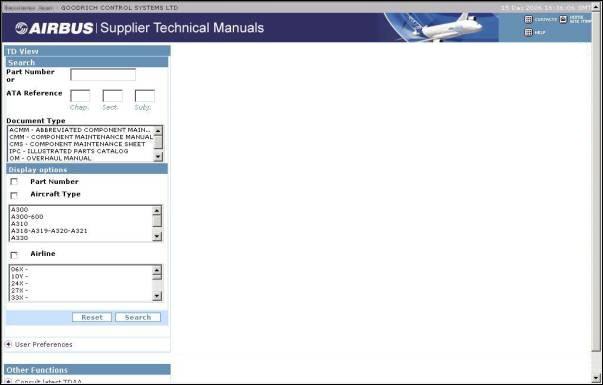
Part Number
Allow to display the Part Number column in the result page in case of an ATA selection.
Search by Aircraft Type
You can either choose to perform a search on all available aircraft types or on a selected group. The display of the result page will add the A/C Type column, if it was not visible.
Search by Airline Code
You can either choose to perform a search on all airlines or on a selected group up to ten items. The display of the result page will add the Airline column, if it was not visible.
Error message:
If the search engine cannot find a result to your query then a “No result found” error message is displayed:

Search Result screen:
The query results section is displayed and described below.
For each document retrieved, the FSCM code, ATA Reference, Document Type, Volume, Revision Number, Revision Date and Format, matching the search criteria are listed.
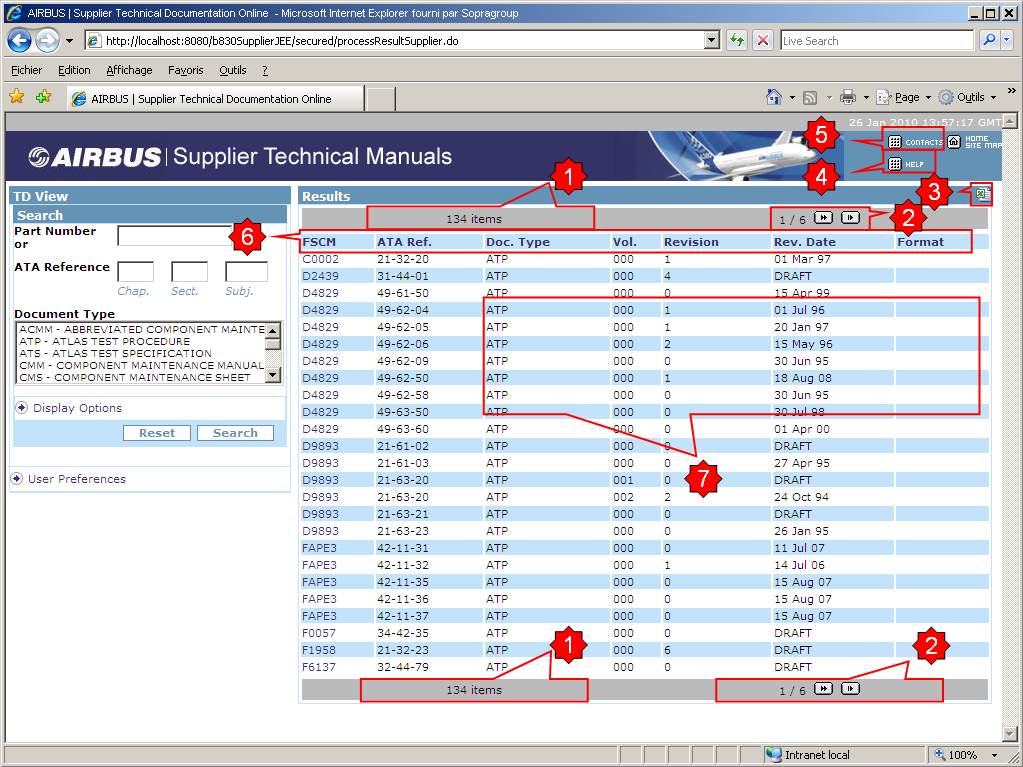
Depending on search criteria selected, the result screen is expanded:
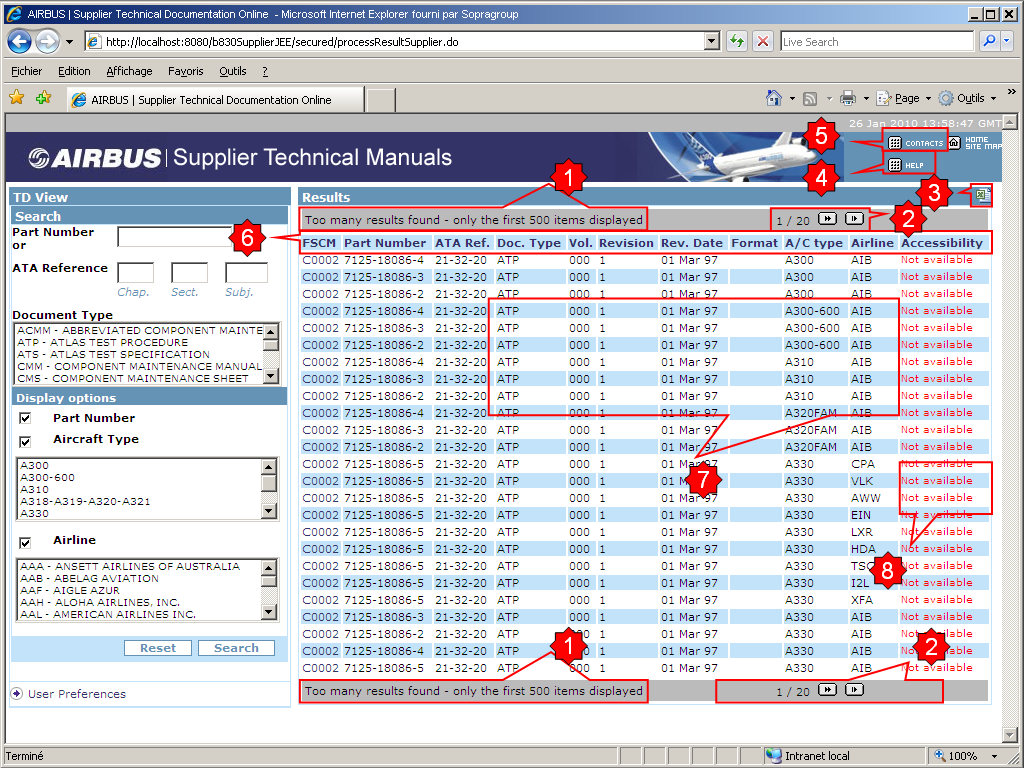
1. Number of records:
The number of records matching the query is displayed in the top and bottom part of the middle frame.
| "XX item(s)": |
Where XX represents the total number of documents matching the query.
|
or
|
| "Too many results found - only the first 500 items displayed": |
The maximum number of returned items is 500.
|
By default twenty five items are displayed in a result page. If more records are retrieved then they will be spread in several pages.“YY / ZZ” Where YY is the current page number and ZZ the maximum number of returned pages.
2. Navigation buttons:
The videocassette recorder (VCR) type buttons allow going to the first, previous, next, and last record of the query results.
3. Download button:
The download button is used to save the total search result list information in Excel format (.XLS). The displayed columns of information are stored.
4. Help:
By clicking this button it will open the following Help document of Supplier Technical Documentation.
5. Contacts:
When clicking on "Contact button", an e-mail message box will open to send a support request.
6. Column titles:
The user can sort the results by clicking on one of the column titles. By default, the results are sorted by FSCM then by ATA Reference
and then by Document type.
7. Opening a document:
The Format column provides a hyperlink to open a document when the accessibility status displays “Available”.
Then clicking on the hyperlink will open the PDF in Acrobat Reader. From there you can save or print the document by selecting the appropriate menu within Acrobat
Reader. Note that Acrobat Reader shall be installed on your computer. Click here for more information concerning the recommended software configuration.
8. Accessibility status:
In front of each result line there is an accessibility status and the meaning is the following:
Accessibility Status
|
Rational
|
Impact
|
|
Available |
The document owner (supplier) agreed that the following document is to be made available to the connected airline user on the AirbusWorld.
The document references at least one equipment item that is installed on the airline's Airbus fleet.
|
The document is accessible.
The related document format displays a hyperlink. By clicking on it, the supplier’s document opens.
|
|
Export control |
An export control license has been issued for the document after either a decision from the U.S. Department of Commerce or the U.S. Department of State.
Therefore, the document owner (supplier) does not authorize Airbus to make the following document available to the connected airline.
|
The document cannot be opened.
There is no hyperlink to the document format.
The airline user is invited to contact the document owner (supplier).
|
|
Not granted |
The document owner (supplier) doesn’t authorize Airbus to make their technical documents available through AirbusWorld.
|
The document cannot be opened.
There is no hyperlink to the document format.
The airline user is invited to contact the document owner (supplier).
|
|
Not available |
Airbus hasn't received yet the supplier document.
Or, the supplier document is in the process to be published on AirbusWorld.
|
The document cannot be opened.
There is no hyperlink to the document format.
|
 TD VIEW - USER PREFERENCES
TD VIEW - USER PREFERENCES
User preferences section:
The user preferences section allows user to define the number of rows (10, 20, 25, 30, 50, 100) to be displayed in the page of results. The number chosen is applied to Search results and Statistics
result pages.

 OTHER FUNCTIONS - CONSULT LATEST TDAA
OTHER FUNCTIONS - CONSULT LATEST TDAA
Consult latest TDAA section:
This section allows to open the latest TDAA documents, by clicking on the hyperlink of date the TDAA will open in Acrobat
Reader.
A list of TDAA documents can appear if the connected user belongs to a group of FSCMs.

 OTHER FUNCTIONS - STATISTICS
OTHER FUNCTIONS - STATISTICS
Statistics section:
Search by ATA Reference
The statistics on ATA Reference can be performed either by specifying only the ATA Chapter or the ATA Chapter and Section or ATA Chapter, Section, and Subject.
Search by Document Type
You can either choose to perform statistics on all document types, or on a selected group.
The list of document types and their signification are detailed above.
Statistics on Airline Code
You can either choose to perform statistics on all airlines or on a selected group up to ten items.
Statistics on a period date
You can select dates (From To) in order to view statistics for this period.
This screen corresponds to a Statistics results for a full search.

 AUDIT FUNCTION
AUDIT FUNCTION
Purpose and scope
The Supplier Technical Documentation Audit allows the audit of the suppliers' maintenance manuals available to Airlines. The audit is done by the supplier. It aims at verifying the content of data and provides a direct feedback to Airbus to improve the data quality provided to Airlines.
Audience
The Supplier Technical Documentation Audit is provided to suppliers only. The access to this feature is managed by the supplier's UEA after Airbus deploys the Audit functionality to the supplier company. The user of a supplier company in charge of the audit is named "supplier's auditor".
Audit Process
The audit process is illustrated in the figure bellow.
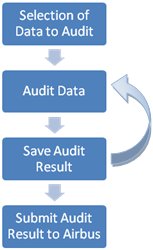
The Audit process is done in 4 steps:
 1. Selection of the Data to Audit 1. Selection of the Data to Audit
The Audit is managed at the FSCM level. The supplier's auditor must select a FSCM to audit the manuals related to this FSCM code.
 2. Audit Data 2. Audit Data
The supplier's auditor checks the manuals data and provides a feedback. For each manual three results are possible:
a. OK. The data are compliant with the supplier's information.
b. NOK. One or more data is not compliant with the supplier's information.
c. New. Within the list of manuals related to the selected FSCM, a manual is missing that can be added by the supplier's auditor.
 3. Save Audit Data 3. Save Audit Data
Audit result is saved to allow the supplier's auditor to manage the audit in several steps.
 4. Submit Audit Result to Airbus 4. Submit Audit Result to Airbus
The supplier's auditor has completed the audit for all the manuals of a FSCM and sends the audit results to Airbus. The audit must be coherent and complete (i.e. all manuals are correctly audited) before submitting.
Audit Content
 Audit FSCM Selection Audit FSCM Selection
The Audit is managed at the FSCM level. When opening the Audit function, the list of FSCM available for the user to audit is returned in the result table.

For each FSCM retrieved, the information listed below are displayed.
 1. FSCM code 1. FSCM code
 2. Company name 2. Company name
 3. Last Save Date 3. Last Save Date
Date of the last time the data related to the audit of this FSCM have been saved.
 4. Last Submit Date 4. Last Submit Date
Date of the last time the data related to the audit of this FSCM have been sent to Airbus.
 5. Status 5. Status
Inform the supplier's auditor that the FSCM is locked by another supplier's auditor. The name of the supplier's auditor currently auditing the manuals of the FSCM is provided as well as the date he has started the audit.
If a FSCM audit is locked by another user it is still available for consultation (no modification are possible at the same time).
The user can sort the results by clicking on one of the column title.
 Audit Screen Audit Screen
The audit screen lists all the manuals of the select FSCM. For each manual the data to audit are: FSCM, ATA Ref., Reference, Doc. Type, Vol., Revision and Rev. Date.
The user can sort the audit screen by clicking on one of the column title.
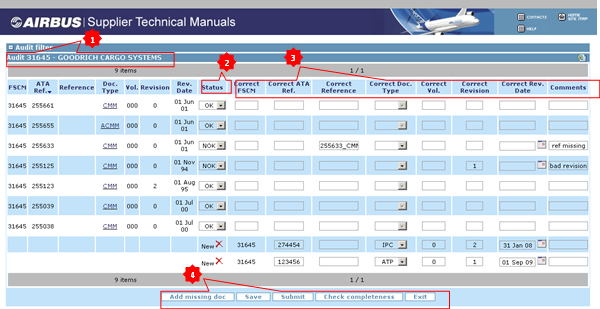
 1. FSCM code and company name are indicated at the top of the audit table. 1. FSCM code and company name are indicated at the top of the audit table.
 2. Status: for each manual, the supplier's auditor provides a feedback in the "Status" field. The possible values are: 2. Status: for each manual, the supplier's auditor provides a feedback in the "Status" field. The possible values are:
a. "empty", when the manual has not been audit yet.
b. OK, when the manual data are compliant with the supplier's information.
c. NOK, when one or more data is not compliant with the supplier's information.
d. New, when within the list of manuals related to the selected FSCM, a manual is missing. The "New" status can be set only by the button "Add missing doc" to reference a missing manual of the audited FSCM.
 3. Correct value fields: correct value of one of the audited data if an incorrect value has been detected. Any of the audited data can be corrected. An optional comment can be edited. 3. Correct value fields: correct value of one of the audited data if an incorrect value has been detected. Any of the audited data can be corrected. An optional comment can be edited.
a. FSCM
b. ATA Ref.
c. Reference
d. Doc. Type
The correct value must be picked in the selection list.
e. Vol.
f. Revision
g. Rev. Date
The correct value is editable through an agenda.
h. Comment
Free text zone.
The correction fields can be filled only if the audited manual status is set to NOK.
At least one of the correction fields (including Comment) must be filled if the audited manual status is set to NOK.
 4. Several functions are provided to the supplier's auditor 4. Several functions are provided to the supplier's auditor
a. Add missing doc
Clicking on the "Add missing doc" button will add a line in the audit table to indicate a manual is missing. The FSCM code is automatically filled with the value of the FSCM the manuals are audited.
b. Save
The "Save" function allows the supplier's auditor to save the audit results to allow him to manage the audit in several steps.
c. Check completeness
The "Check completeness" function checks that the audit has been completed, i.e. that all the documents have been correctly audited.
The audit of a FSCM is completed in the following conditions:
. All the audited manual's status are defined (OK, NOK or New)
. For each audited manual which status is equal to "NOK" at least one correction field is filled (including "Comment")
. For each audited manual which status is equal to "New" all the correction fields except "Reference" (or ATA) and "Comment" are filled.
An error message is returned to the user if the audit is not completed.
d. Submit: send the audit result to Airbus.
The "Submit" function allows the supplier's auditor who has completed the audit of FSCM manuals to send the audit results to Airbus. The audit must be completed, i.e. all manuals are correctly audit, before submitting.
It is not possible to submit if the Check completeness function returns errors.
The submit function automatically save the audit content.
e. Exit
The Exit button exits the current window and goes back to the Audit FSCM Selection screen. Modified data are not saved (changes are discarded).
 Audit Filtering Audit Filtering

The user has the possibility to filter the content of the table using the Audit filter banner. The filter criteria are:
 ATA Ref. ATA Ref.
 Reference Reference
 Doc. Type Doc. Type
 Status Status
 COMPONENT DATA SHIPPING LIST (CDSL)
COMPONENT DATA SHIPPING LIST (CDSL)
Purpose and scope
The CDSL is a report customized per FSCM with applicability data (Airline and A/C type).
The objective is to list all the documents which have been provided or have to be provided to the Customers.
Airbus and Suppliers will be able to monitor their shipping activities based on the "Doc Sent" column.
CDSL section:
To find the CDSL application, please go to the left part of the screen, below the 'Audit Function'.

To execute the query, click on the Search button or restart a query by pressing on the Reset button.
There is not maximum number of results displayed for this search, all the data are retrieved by the search.
A wait message is displayed to the user to warn him the "CDSL" is being generated.
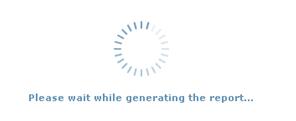
 Search by FSCM Search by FSCM
You can either choose to perform a search on all available suppliers or on a selected group.
 Search by ATA Reference Search by ATA Reference
The search by ATA Reference can be performed either by specifying only the ATA Chapter or the ATA Chapter and Section or ATA Chapter, Section, and Subject.
 Search by Reference Search by Reference
The search by Reference is not case sensitive.
You can either type the whole 25 characters or the three characters followed by a wildcard (e.g. *). Authorized characters are numbers, letters, '-', and '*'.
 Search by Document Type Search by Document Type
You can either choose to perform a search on all document types, or on a selected group.
The list of document types and their signification are detailed above.
 Search by Aircraft Type Search by Aircraft Type
You can either choose to perform a search on all available aircraft types or on a selected group.
 Search by Airline Search by Airline
You can either choose to perform a search on all available airline or on a selected group.
 Search by Part Number Search by Part Number
The search by Part Number is not case sensitive.
You can either type the whole 15 characters or the three characters followed by a wildcard (e.g. *).
Authorized characters are numbers, letters, '-', and '*'. The Part Number is displayed in the result screen.
Error message:
If the search engine cannot find a result to your query then an "No result found" error message is displayed:
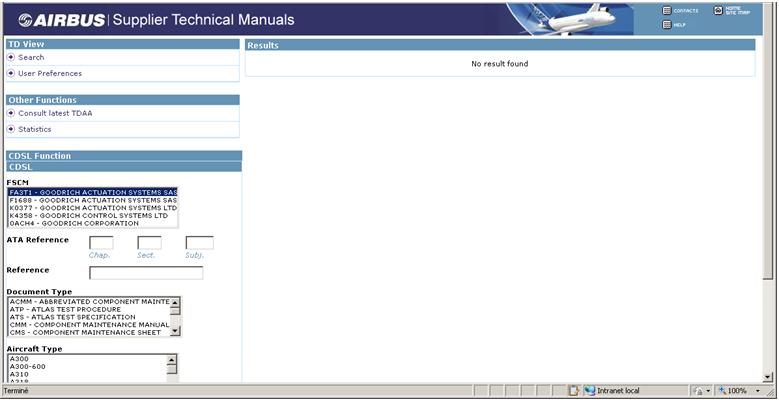
Search Result screen:
The query results section is displayed and described below.
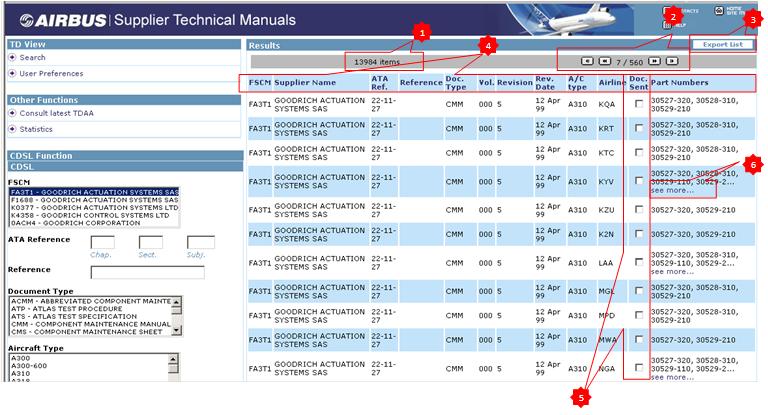
 1. Number of records: 1. Number of records:
The number of records matching the query is displayed in the top and bottom part of the middle frame.
"XX item(s)" : Where XX represents the total number of documents matching the query.
 2. Navigation buttons: 2. Navigation buttons:
The videocassette recorder (VCR) type buttons allow going to the first, previous, next, and last record of the query results.
If there are more records than the value set in the "User preferences" menu, then they will be spread in several pages.
"  YY / ZZ YY / ZZ  "
Where YY is the current page number and ZZ the maximum number of returned pages. "
Where YY is the current page number and ZZ the maximum number of returned pages.
 3. Download button: 3. Download button:
The download button is used to save the total search result list information in Excel format (.XLS). The displayed columns of information are stored.
 4. Column titles: 4. Column titles:
The user can sort the results by clicking on one of the column titles. By default, the results are sorted by FSCM then by ATA Reference and then by Document type.
 5. Doc. Sent Column: 5. Doc. Sent Column:
The check box "Doc. Sent" allows the supplier to know the A/L the supplier has already sent the documentation.
 6. "See more..." link: 6. "See more..." link:
In the "Part Numbers" column, when the list of all part numbers to display is longer than a configurable number of characters (property of the application), then it is truncated and "..." is displayed just after.
A link "see more..." is displayed on the next line :

When clicking on this link, a popup is opened and shows the complete list of part numbers, with 1 line per item :
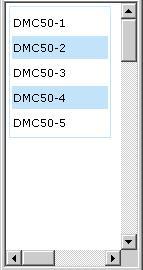
 CONTACTS
CONTACTS
For further assistance regarding the STDO application, please contact the Help Desk at AIRBUS
(24h a day and 7 days a week):
Phone Number: +33 (0)5 67 19 11 00
mailto:airbusworld@airbus.com
Recommended Software Configuration specific for STDO application
- Internet Explorer 6 SP1 or greater
- Mozilla Firefox 2 or greater
Adobe Acrobat, Microsoft, Windows, and Excel are trademarks protected by their respective owners.
|
© Airbus S.A.S. 2007. All rights reserved.
|
|